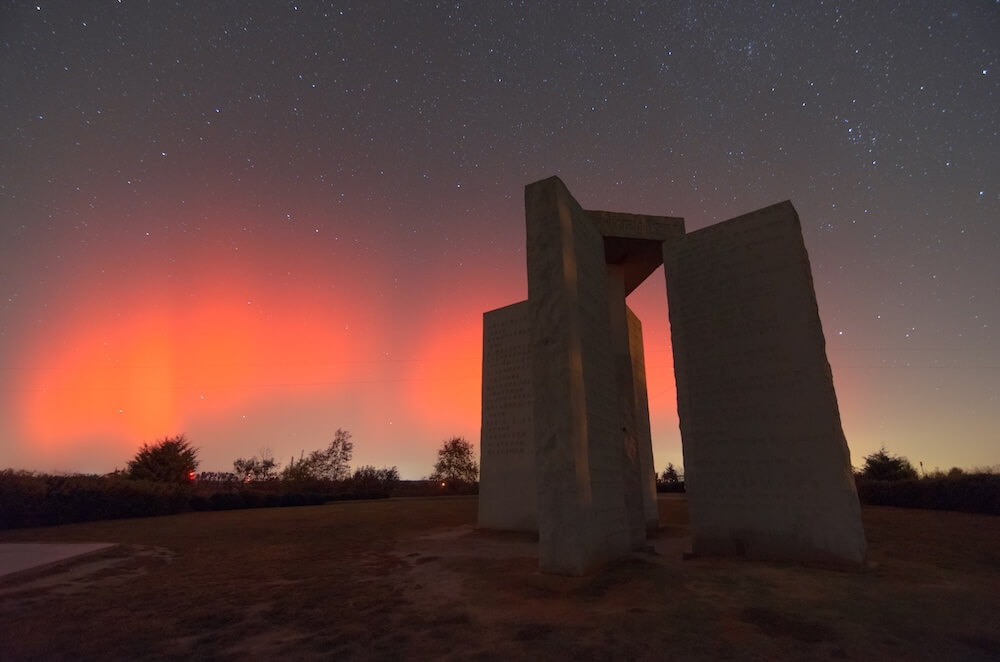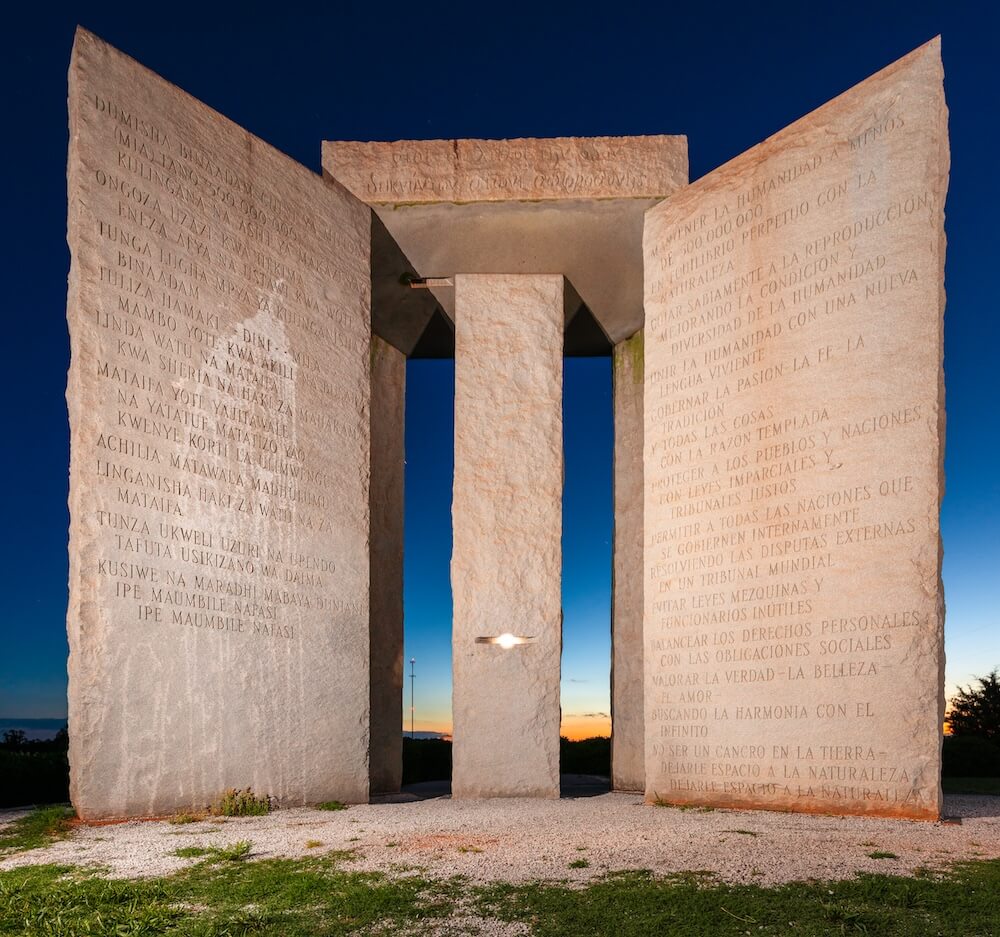For 42 years, a strange granite monument stood on a hilltop in rural Georgia, giving cryptic advice for a world after the end of the world. This mysterious building, known as the Georgia Guidestones, sparked decades of conspiracy theories, religious fervor, and heated debate before it blew up in July 2022. One of America's most controversial monuments was meant to be a guide for people to survive.

The Mysterious Commission
In the summer of 1979, a well-dressed stranger walked into the Elberton Granite Finishing Company offices in Elbert County, Georgia. This is where the story begins. He called himself Robert C. Christian, which was a carefully chosen fake name. He made an unusual request to Joe Fendley, the president of the company.
Christian said he spoke for a small group of "loyal Americans" who had been planning a monument for twenty years that would help people get through future disasters. He talked about nuclear war, the end of society, and environmental disaster as threats that were about to happen. He said that his project was necessary for the survivors of civilization.
He gave mind-boggling details: six huge granite slabs, weighing more than 237,000 pounds together, arranged in a precise astronomical pattern, and carved with ten principles in eight modern languages and four ancient scripts. In 1979, the estimated cost was more than $100,000, which is about $400,000 now.
At first, Fendley was doubtful, but Christian proved he had the money by working with local banker Wyatt Martin. The banker was the only person who knew Christian's real name, and he promised to keep it a secret for the rest of his life.
A Monument to a Time of Reason
The Georgia Guidestones were revealed on March 22, 1980, the spring equinox. They were 19 feet tall and made up of four vertical granite slabs that held up a capstone. The center stone served as both a support and an astronomical instrument. The structure was perfectly in line with the movements of the stars. Holes drilled through the stones let people see the North Star, the solstices, and the equinoxes. A carefully placed hole in the capstone made a solar calendar.
The capstone of the monument had an inscription in four ancient languages: Babylonian cuneiform, Egyptian hieroglyphics, Sanskrit, and classical Greek. It said, "Let these be guidestones to an age of reason."

But the ten rules written on the vertical slabs in eight modern languages would cause the most trouble. These were the "commandments for a new age":
- Keep the number of people below 500 million in a state of balance with nature.
- Guide reproduction wisely to improve fitness and diversity.
- Unite people with a living new language.
- Rule passion, faith, tradition, and all things with tempered reason.
- Protect people and nations with fair laws and just courts.
- Let all nations rule themselves, settling disputes with other nations in a world court.
- Avoid petty laws and useless officials.
- Balance personal rights with social duties.
- Prize truth, beauty, love, and the search for harmony with the infinite.
- Do not be a cancer on the Earth; leave room for nature.
The Start of the Conspiracy Theories
People were suspicious and angry about the Georgia Guidestones as soon as they were revealed. Critics were especially upset about the first commandment's call to keep the world's population below 500 million, which is about 93% less than the number of people who live on Earth now.
Conservative Christians called the monument "the Ten Commandments of the Antichrist" because they thought it was a satanic twist on biblical teachings. People only speculated more about hidden agendas and secret societies because of the strange way it was made.
Many conspiracy theorists came up with different ideas about the monument's real purpose and who paid for it:
New World Order Blueprint: Many people thought the Guidestones were a plan for a global totalitarian government because they called for world courts, population control, and international governance.
Link to Rosicrucians: Robert Christian's initials, "R.C.," made people think of the Rosicrucian order, a secretive philosophical group started by the famous Christian Rosenkreuz. This theory gained popularity because the monument focused on reason over faith and had features that looked like stars.
Illuminati Monument: Some people thought the building was built by the secret society of the same name, and they saw its ideas as a way for the elite to control a smaller world population.
Occult Portal: Some more obscure theories said that the Guidestones were a mystical gateway or focal point for supernatural energies, and some even said that the site was used for occult rituals.
The Identity Mystery
For many years, the real name of R.C. Christian was one of the most interesting mysteries in America. When Wyatt Martin, the banker who took care of the money, died in 2021, he kept Christian's secret and promised never to tell anyone the name.
But a breakthrough came from an unexpected place. "Dark Clouds Over Elberton," a documentary by Christian J. Pinto that came out in 2015, showed Martin reading some of Christian's letters. A close look at the video showed an important detail: a return address and a postmark from Fort Dodge, Iowa.
CNN's investigative reporting in 2024 built on this finding and found that the address belonged to Dr. Herbert Hinie Kersten, a doctor who lived there from 1920 until his death in 2005. There were a number of reasons why this identification was correct:
- Kersten was 78 years old in 1998, which is the same age Christian said he was in a letter from that year.
- He was a well-known supporter of population control and protecting the environment.
- His writings on overpopulation and eugenics were very similar to what Christian had said.
- He had also shown interest in building monuments to keep knowledge alive for future generations.
Kersten's family, on the other hand, says he wasn't involved, and some researchers point to more troubling aspects of his beliefs, such as claims that he held racist views and admired white supremacist figures. These new facts make the monument's intended message of universal human guidance seem less bright.
The Campaign of Vandalism
The Georgia Guidestones have been vandalized many times since they were built. Graffiti that said "Death to the New World Order" was found on the monument in 2008. Other events included using spray paint and trying to chip away at parts of the stone.
As more and more conspiracy theories spread online, the attacks got worse. In 2020, radio host Alex Jones went to the site and called it "the birthplace of the modern depopulation movement." Right-wing activists, like Mark Dice, wanted the monument torn down because they thought it was a symbol of evil forces.
The political climate in 2022 made people even more angry about the Guidestones. Kandiss Taylor, a Republican running for governor of Georgia, promised to tear down the monument as part of her campaign. She called it "satanic" and said she would do it by executive order if she won.
The Last Blast
An explosive went off at the Georgia Guidestones site in the early morning hours of July 6, 2022. The explosion destroyed one of the four main slabs and badly damaged the capstone. Security cameras caught it. The video also showed a car leaving the scene, but no one was arrested.
Local officials used heavy machinery to tear down the rest of the building later that day, saying it was unsafe. An unknown vandal's bomb destroyed the monument after 42 years, despite years of controversy surrounding it.
The Georgia Bureau of Investigation looked into the bombing, but as of 2025, no one has been arrested. The name of the person or people who did it is still a mystery, adding to the already mysterious history of the Guidestones.
Legacy and Meaning
The Georgia Guidestones were one of the most controversial monuments in the United States, and their destruction ended that. However, people still have questions about what they meant and what their message was. Supporters saw it as a logical way for people to survive global disasters by focusing on taking care of the environment, keeping the population in check, and governing with reason.
Critics saw something much worse: a plan for authoritarian control that was dressed up in humanitarian language. People who thought the call for a drastic reduction in the population was a call for genocide or mass sterilization programs were especially alarmed.
The monument's astronomical features and focus on keeping knowledge alive across language barriers showed that the people who built it really cared about the long-term survival of humanity. But the secretive way it was made and the fact that its patron was a controversial figure raised real concerns about hidden motives.
Scientific and Academic Points of View
Most mainstream scholars thought the Georgia Guidestones were an interesting example of modern folk architecture, not a sinister plot. Loris Magnani, an astronomer at the University of Georgia, said that the astronomical alignments were "mediocre at best" and that they were like a "abacus compared to Stonehenge's computer."
The principles, devoid of conspiratorial interpretations, predominantly mirrored the prevalent environmental and humanitarian concerns of the late 20th century: sustainable population levels, international collaboration, environmental conservation, and rational governance. Similar concepts emerged in scholarly literature, United Nations reports, and prominent environmental movements.
But the monument's secretive creation and the patron's apparent eugenic beliefs made it hard to do a simple academic evaluation. The building was located at the crossroads of legitimate conservation concerns and more troubling ideological currents.
The Scale of Mystery
The Georgia Guidestones represented one of the most enduring mysteries in American history. Despite decades of investigation, conspiracy theories, and intense public scrutiny, the true identity of their creator and the complete story behind their construction remained largely unknown until recent documentary evidence emerged.
Relevance Today
The Georgia Guidestones phenomenon highlights larger problems in modern American society. People were worried about globalization, population control, and elite manipulation, and the monument became a lightning rod for those worries. These worries still affect political discourse today.
The fact that people quickly came up with conspiracy theories about the structure shows how secretive origins and unclear messaging can turn good projects into targets for extremist interpretation. The bombing that happened later is an example of what can happen when people don't question their own conspiracy theories.
Some of the monument's main issues, like pollution, too many people, and wars between countries, are still big problems around the world. Policymakers and activists around the world are still having trouble figuring out how to deal with these problems without making people afraid of authoritarian control.
The Danger of Conspiracy Thinking
The destruction of the Georgia Guidestones serves as a stark reminder of how conspiracy theories can escalate into real-world violence. When mysterious circumstances combine with controversial messaging, they can create dangerous misunderstandings that lead to destructive actions.
Conclusion: What We Learned from the Rubble
The story of the Georgia Guidestones is a warning about how to handle mystery, messaging, and how the public interprets things. What may have started as one person's honest effort to help humanity's future has turned into a symbol of feared oppression and hidden agendas.
The destruction of the monument shows how conspiracy theories can make people do things in the real world and how hard it is to talk to people who have different views. The fate of the Guidestones teaches us important lessons about the difficulties of public discourse in a time when people are becoming more polarized and less trusting of institutions.
The story shows how important it is for public monuments and messages to be clear and accountable. The secretive circumstances that led to the creation of the Guidestones made them more mysterious, but they ultimately failed to achieve their stated goal of giving people rational guidance.
There is now only an empty field where the granite monument used to be. The messages that were meant to help people get through future disasters are now only in pictures and memories. People still argue about what they mean, but their physical presence is gone forever because of the forces they helped set free.
The Georgia Guidestones may now be a stronger symbol than they ever were as a physical structure, since they were destroyed. They show how complicated it is to balance intention and interpretation, mystery and understanding, and the desire to help people with the unintended effects of doing so in secret.
"The Georgia Guidestones stand as a testament to the power of mystery in the modern age. What began as perhaps a sincere attempt to guide humanity became a lightning rod for fears and suspicions that ultimately led to its destruction."
